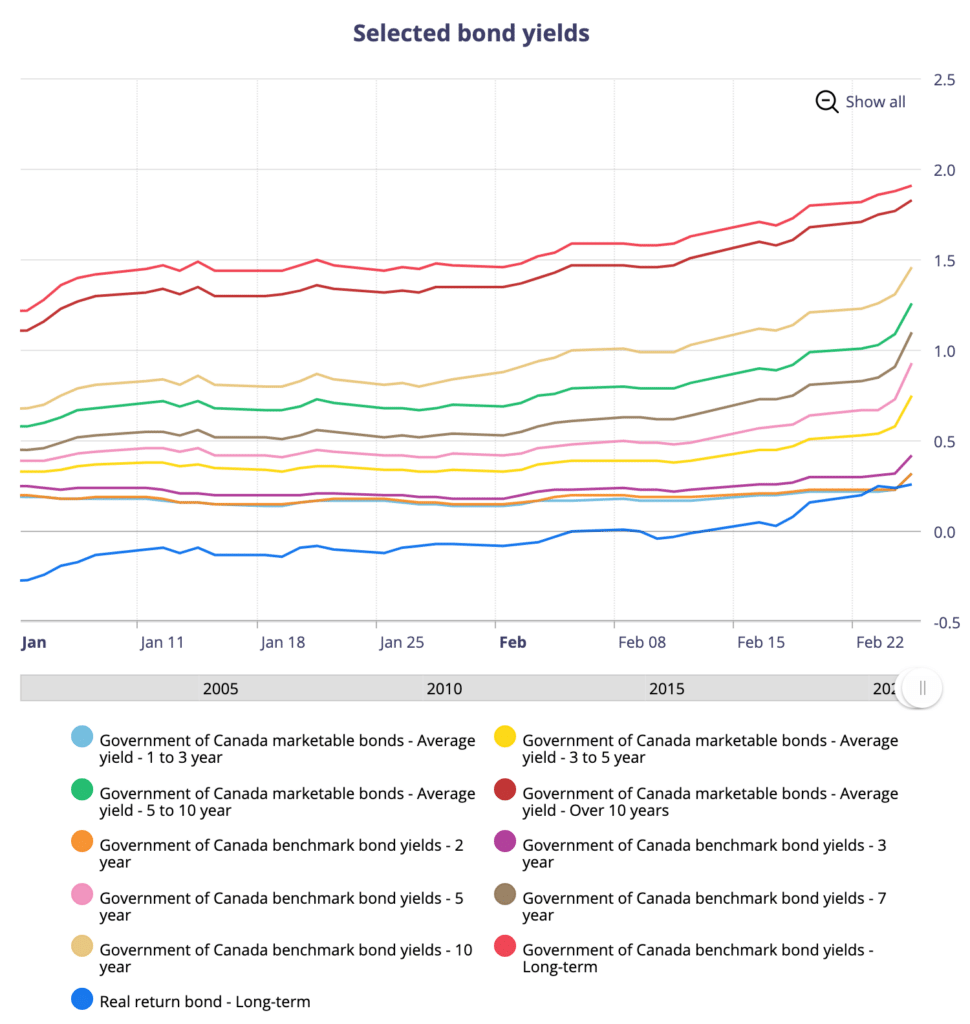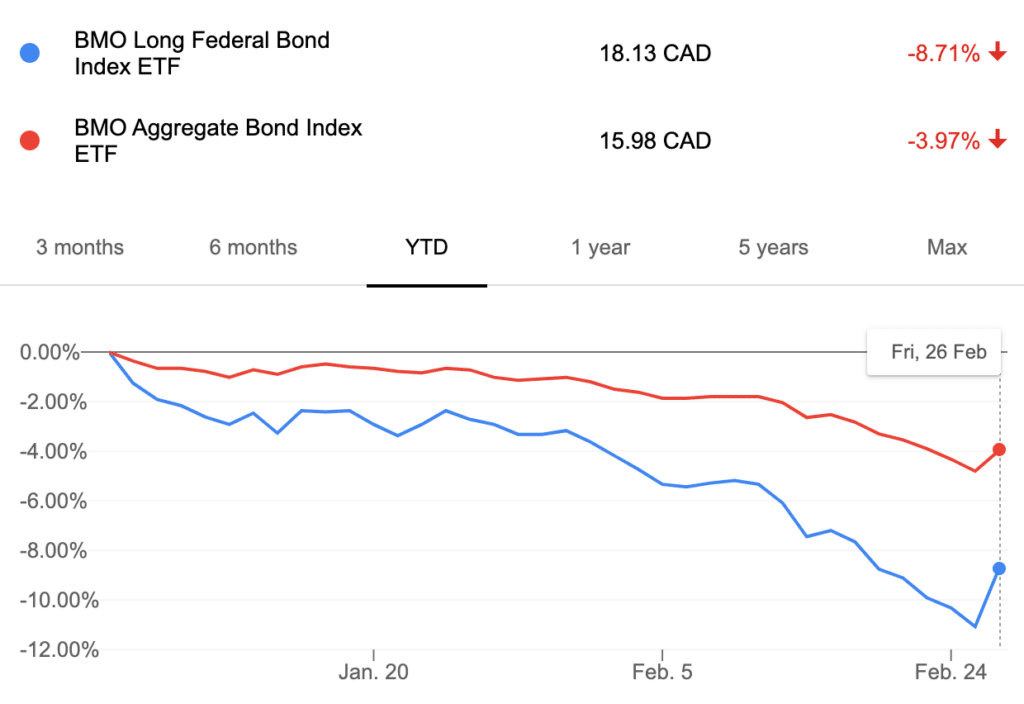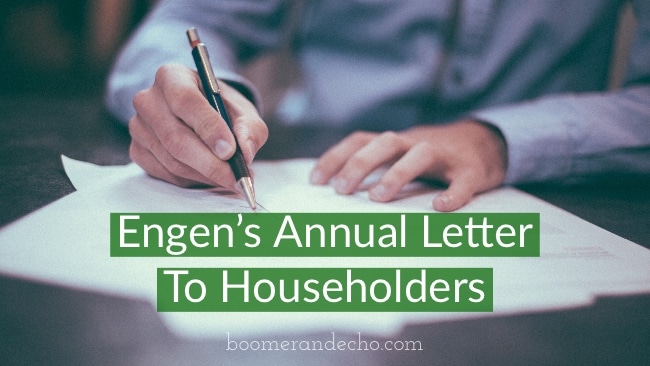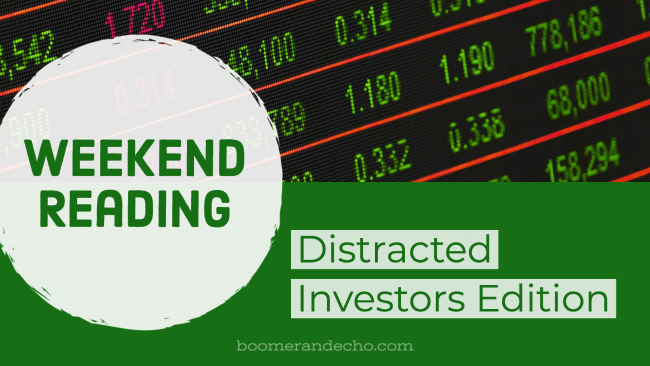
Bonds are meant to be the ballast that helps smooth out volatility in your portfolio. They act as a cushion – the steady yet unspectacular asset class that balances the unpredictable movement of stocks. But a sudden decrease in bond prices has investors looking for answers.
In short, bond yields are on the rise because investors are optimistic about future economic growth. The U.S. 10-year Treasury yield climbed to its highest level in more than a year. Here in Canada, 10-year government bond yields have more than doubled since the beginning of January.

Rising rates spell trouble for bond prices, though. Long-term bonds are particularly sensitive to changes in interest rates. A good way to measure that sensitivity is by looking at a bond’s duration. A bond with a duration of 5 years will see its price fall by 5% if interest rates rise by 1% (and vice versa).
BMO’s ZFL, which tracks Canada’s long-term federal bond index, has an average duration of 17.94. The price of ZFL fell by 11.08% as of Thursday before a slight uptick in prices on Friday. BMO’s popular ZAG ETF, which tracks the Canadian aggregate bond index, has an average duration of 8.1 years and its price was down 4.81% as of Thursday.

Short-term bond ETFs have a lower yield but they are less sensitive to interest rate movements and more preferable to hold in a rising rate environment.
The iShares Core Canadian Short Term Bond Index ETF (XSB) has an average duration of 2.71 years. Its price is down just 1.10% on the year, compared to the iShares Core Canadian Universe Bond Index ETF (XBB), which has an average duration of 7.91 years and is down 3.87% year-to-date.

The silver lining for bond holders is that you’re still getting interest payments from your bonds, and those payments should eventually rise as new bonds are purchased at higher interest rates. That’s why investors with a long time horizon should stick to their plan and rebalance – buying bonds at low prices and higher yields.
Retirees, on the other hand, should consider the average duration of their bonds and determine if it’s appropriate for their age and stage of life. Clearly, holding long-term bonds when you have short-term spending needs is not a wise strategy.
Fears over rising interest rates have plagued investors for the past decade. As this 2011 article from Canadian Couch Potato Dan Bortolotti explains:
“The key message for investors: as long as your time horizon is at least as long as the duration of your bond fund, you won’t lose any capital. Any price decline from rising interest rates will be offset by higher coupons within that time frame. In fact, history suggests the recovery is likely to be more swift than that: even a three-year period of negative bond returns is extremely rare.”
This Week’s Recap:
Earlier this week I wrote my annual letter to Engen Householders.
Read the Oracle of Omaha Warren Buffett’s annual letter to Berkshire shareholders here.
From the archives: Why I Don’t Hold Bonds in My Portfolio.
Promo of the Week:
The American Express Cobalt Card is arguably the best ‘hybrid’ card in Canada. Cardholders earn 5x points on groceries, dining, and food delivery, plus 2x points on transit and gas purchases.

New Cobalt cardholders can earn 30,000 points in their first year (2,500 points for each month in which you spend $500) plus, you can earn a welcome bonus of 15,000 points when you spend a total of $3,000 in your first 3 months.
Sign up for the Cobalt card here.
Weekend Reading:
Our friends at Credit Card Genius share how you can take advantage of record low interest rates in Canada.
Jim Wang at Wallet Hacks brilliantly explains what you should do with all the financial advice on the internet.
A fantastic piece by Morgan Housel on investing and speculation – when everyone’s a genius.
For Globe and Mail subscribers, Rob Carrick explains that what’s happening with housing and stocks is not normal:
“Gen Xers, boomers and older generations have one benefit young adults lack in making sense of what’s happening now – perspective. If you opened your eyes to personal finance and investing in the pandemic, you’re seeing things that may never happen again. Take advantage, and take care.”
What would Warren Buffett make of this stock market silly season? He’s already told us.
A perfectly timed new video by PWL Capital’s Ben Felix on the pitfalls of chasing star fund managers:
With the 2020 RRSP deadline fast approaching, My Own Advisor Mark Seed shares RRSP facts you must remember this year and beyond.
Michael James on Money explains that the great thing about managing other people’s money (from a fund manager’s perspective) is you can dip into it to pay yourself.
On the Evidence Based Investor, Larry Swedroe looks at the odds of outperformance through active management.
A Wealth of Common Sense blogger Ben Carlson debunks everyone’s favourite hyperinflation scenario.
Of Dollars and Data blogger Nick Maggiulli sold his Bitcoin. Have fun staying poor.
Global’s Erica Alini reports that fixed mortgage rates are on the rise.
Finally, this New York Times article takes an interesting look at how boredom is impacting the economy today.
Have a great weekend, everyone!

Inspired by the folksy wisdom in Warren Buffett’s annual letter to Berkshire shareholders (scheduled for Feb 27, 2021), I decided to write my own letter. I don’t have any shareholders so this letter is written to my family, or my householders.
Alas, I don’t expect anyone to make the pilgrimage to Lethbridge, Alberta for our annual household meeting, so instead you’ll get to read Engen’s annual letter to householders.
Engen’s annual performance versus the market
| Year | My personal rate of return | TSX Composite annual rate of return | S&P 500 annual rate of return |
|---|---|---|---|
| 2009 | 35.54% | 30.70% | 26.46% |
| 2010 | 14.20% | 14.50% | 15.06% |
| 2011 | 9.80% | -1.01% | 2.11% |
| 2012 | 12.30% | 7.33% | 16.00% |
| 2013 | 13.60% | 12.83% | 32.39% |
| 2014 | 8.50% | 10.23% | 13.69% |
| 2015 | 9.40% | -8.22% | 1.38% |
| 2016 | 8.80% | 21.08% | 11.96% |
| 2017 | 14.10% | 8.92% | 21.83% |
| 2018 | -4.36% | -8.86% | -4.38% |
| 2019 | 21.71% | 22.86% | 31.49% |
| 2020 | 10.24% | 4.60% | 18.40% |
To the Householders of Engen Inc.
The Engen family’s gain in net worth during 2020 was $184,645 which represented an increase of 22.3% over 2019. Over the last 11 years (since I started this blog) our household net worth has grown from $102,200 at the end of 2009 to $1,013,141 by the end of 2020 – a rate of 23.2% compounded annually.
There are five building blocks that add value to the Engen family’s finances: (1) high savings rate; (2) no new debt; (3) minimizing cost of living increases; (4) investment earnings from our portfolio of stocks; and (5) increasing income.
High savings rate
We’ve always tried to maintain a high savings rate and 2020 was no exception. Between our RRSP, TFSA, and RESP accounts, we managed to save one-third of our income. That’s in addition to the $100,000 we were able to invest inside our new Corporate Investment Account.
Looking ahead, these savings categories will have to be reassessed beyond 2021 as we have maxed-out both my wife’s and my RRSP contribution room along with my unused TFSA room.
Thankfully, TFSA contribution room is plentiful in my wife’s account and that will be our focus this year with a planned $50,000 in TFSA contributions for her account plus the $6,000 annual TFSA limit going into my account.
RESP contributions are currently maxed-out each year ($2,500 per child) and will be until our children are ready to attend post-secondary.
Our savings rate will actually tick-up to 37% in 2021.
No new debt
Both of our vehicles have been paid off for years and that has allowed us to direct more of our income towards our savings goals and for travel (ha!). We’ve also paid off our home equity line of credit that we used to complete our basement renovation.
We haven’t had any non-mortgage debt for two-and-a-half years. Even though rates are ultra low, we don’t plan to take on any new debt in the near term.
Speaking of our mortgage, we’re halfway through a five-year term with a 1.45% variable interest rate. We’re in no hurry to pay this down, although with the balance now well below $200,000 we believe the next mortgage renewal (in 2023) will be our last one.
Minimize cost of living increases
Raising a family is expensive. Our annual grocery spending now far exceeds what we pay onto our mortgage. What we saved on dining expenses in 2020 was offset by an increase in our wine budget (sorry, not sorry).
Our spending on kids’ activities was down slightly in 2020, thanks to most sports being shutdown over the spring and fall. We expect these costs to continue to rise though as our kids remain in weekly piano and ballet lessons, plus an expected return of some sporting activities later this year.
As I mentioned, we haven’t had a vehicle payment for several years and don’t plan to upgrade our 2007 and 2013 model vehicles any time soon.
I’m a firm believer that Canadians spend way too much money on vehicles, as evidenced by the auto industry’s record sales every year. How many families have two brand-new leased or financed vehicles sitting in their driveway?
The Engen strategy for saving big money is to drive our paid-off vehicles for at least another five years before we even think about purchasing a new one. That will save us $10,000 per year, an amount that will be saved towards our early retirement fund.
The key to managing all of this is budgeting and planned spending – something we’ve been mastering for the past decade and still find tremendous value in each year.
Investment earnings from our portfolio of stocks
Our RRSP portfolio has grown large enough (at ~$250,000) that market changes rather than personal contributions is now the biggest driver of performance.
You see, while our high savings rate is important, that mattered much more in the early years of investing. A 10% return on $10,000 is only $1,000, but a 10% return on $250,000 is $25,000. That kind of compounding starts to make a big difference once your portfolio reaches six-figures or more.
And, while many investors like to focus on the amount of dividends a portfolio can generate, the way I look at it I’m still in the accumulation phase of my investing journey and so I’m most interested in the total returns from my portfolio. After all, if I were a dividend investor I’d be re-investing those dividends anyway, not spending them.
With my one-ticket investing solution (Vanguard’s VEQT), my portfolio is automatically rebalanced and requires no maintenance from me besides adding new money from time to time.
Increasing income
It was a good decision to leave my day job in the public sector at the end of 2019. Wages had stagnated for years and the situation in post-secondary is far worse now thanks to the pandemic.
It was fortuitous that I started this blog back in 2010. Since then, through a combination of hard work and luck, I managed to earn more than $500,000 (before expenses) through advertising, freelance writing, and fee-only financial planning.
Not all of that went back into our household finances, mind you, but we did withdraw an extra $3,000 or so every month to help accelerate our savings goals.
That side hustle has now turned into a full-time career for me and my wife, and we managed to double the business revenue in 2020.
We also found other ways to increase our income each year; earning credit card rewards on our spending, and selling unused items on Facebook and Kijiji.
Increasing income has been the number one difference maker in our household finances over the last 10 years. This hasn’t come from big bonuses or big jumps in salary. In fact, we were a single-salary household and I had never earned six-figures in a year.
Instead, I’ve hustled and found the right opportunities to turn my passion into a full-time business venture. I hope to instil the same entrepreneurial mindset into our kids as they get older.
Final thoughts
As we look to the year ahead we’ll continue to focus on these five pillars that have laid the foundation for financial success.
It’s these building blocks, stacked slow and steady, year after year, that help us reach such lofty ambitions as having a million-dollar net worth by age 41, and becoming financially free by age 45. They allow us to spend freely on things we care about, and save big on things we don’t.
More than anything, they’re the financial values we share as a household, a compass to guide us through life’s milestones and to our destination.
Next year we’ll be that much closer to it. Until then.

It’s easy for investors to get distracted away from their primary goals these days. Bitcoin is already up 94% year-to-date. The ARK Innovation ETF (NYSE: ARKK) has posted returns 19.45% so far this year. Meme-stock darling GameStop (NYSE: GME) is still up 133.68% on the year even after its historic rise and fall. Clean energy stocks and ETFs, while stumbling out of the gate in 2021, have soared year-over-year, including the Invesco Solar ETF (NYSE: TAN), which has eye-popping 1-year returns of 171.38%.
ETF providers are tripping over themselves to capitalize on the cryptocurrency, clean energy, and technology frenzy. Earlier this year, BMO launched a suite of ‘disruptive innovation’ ETFs to try to mimic ARK’s success. BMO, Horizons, and iShares have introduced more clean energy products to their line-ups. Finally, this week saw the emergence of Canada’s first (and second) Bitcoin ETFs from Purpose and Evolve.
It’s like the explosion of mutual funds all over again. Shiny new objects everywhere!
So, why not throw some play money into these sectors, as many of my readers and clients have done?
Emotional robot investors like me aren’t swayed by shiny things. I’m fully invested in Vanguard’s VEQT across all accounts. Over the past year I’ve posted ho-hum returns of 18.31% in my TFSA and 14.32% in my RRSP.
Sure, those returns pale in comparison to some of these exciting new products and asset classes. But I’m not investing for the best 1-year returns. My low cost, broadly diversified portfolio is designed to give me the most reliable outcome over the long-term.
Besides, we know how this ends. A stock, ETF, or sector outperforms by a wide margin over a short period of time. Assets pile in as investors chase past performance. The stock, ETF, or sector then fails to continue the strong performance and reverts back to the mean. Rinse and repeat forever.
The last investors to get in typically get burned. We’ve seen this with oil & gas stocks, with cannabis stocks, with dot com stocks, with bio-tech and pharma stocks. It’s the same story.
Forget the notion of this time it’s different due to a technological revolution or paradigm shift. Railway mania was followed by a railway bust. The roaring 20s ended in the Great Depression. The infrastructure boom of the 1980s was followed by several busts. And the surge of IPOs in the internet bubble ended in a crash. This time isn’t different:
I don’t personally allocate ‘play money’ to my investments, but I understand why investors might want to. If you can’t resist the urge to play the markets, do yourself a favour and design some rules around this behaviour. Rules like allocating no more than 5% of your portfolio to play money. Have a “sell” target price to deal with your winners and losers so you know when to take profits and when to cut your losses.
I know it’s an exciting time to invest when seemingly everything is going up, including these shiny new products. You feel like an idiot holding a boring portfolio of index funds while investing newbies are striking it rich.
But ask yourself, do you want to be the greater fool who is willing to pay the highest price before a crash? We don’t know how long it takes for a bubble to burst, but we do know that it will burst eventually. Growth stocks fizzle out when earnings disappoint. Star fund managers fade when their assets become too large to maintain their advantage.
As for Bitcoin, well that story is still being written but the current price is more than 3 times higher than its last peak in 2017. That ended with a rapid 80% decline that took three years to recover. Maybe best to catch the next wave…
This Week’s Recap:
No new posts from me this week but I did want to share the winner of the Retirement Heaven or Hell book giveaway and the TurboTax free product code giveaway.
Congratulations to Dean, who commented on February 13th at 1:37 p.m. You’ve won a copy of Retirement Heaven or Hell.
And, congratulations to the following four readers who commented on my TurboTax Full Service Self Employed Review. You’ve won a free product code to try any of the three TurboTax Self-Employed products:
- Braden Bulmer
- Louie M
- Bruce
- Ashley
Thanks to everyone who entered to win these giveaways!
Weekend Reading:
Our friends at Credit Card Genius share the best instant approval credit cards in Canada – from no credit to excellent credit.
Here’s a great piece from Andrew Hallam about why he doesn’t include play money in his portfolio:
“If you want to play with money, spend it. Take a vacation. Buy something for a friend. Enjoy an activity you’ll never forget. That’s where “play money” should go.”
A Wealth of Common Sense blogger Ben Carlson shared 12 things he reminds himself of when markets go crazy.
Who really traded GameStop stock? And what happened to them? Wealthsimple digs into their own client data to find out how traders behaved.
Morningstar’s Ruth Saldanha with a great reminder to stay away from Group RESPs. I couldn’t agree more.
Most robo advisor platforms offer socially responsible investing options. The Corporate Knights blog looks at how green are your “responsible” robo advisors?
Are you sitting on a pile of travel rewards points? I know I am. Travel expert Barry Choi explains why cashing in your travel points now may not be the best deal.
I loved this post from Jesse Cramer of The Best Interest blog. He looks at something called bimodal spending, which asks you to say either “hell yes!” or “hell no!” to major expenses.
Speaking of spending, Michael James on Money looks at which accounts you should spend from first in retirement. His approach closely resembles what I recommend for my clients. Start with your non-registered money, but also spread out your RRSP withdrawals over a longer period of time (rather than waiting until age 72). TFSAs are last in line, and hopefully you’re still able to contribute to your TFSA to build up your tax free assets.
Here’s Ben Carlson again with the biggest difference between now and the dot com bubble.
And, here’s Andrew Hallam again on how wildly successful investments can also become a curse.
Finally, a spirited debate on advisor fees and whether a 1% assets-under-management fee is overcharging investors versus an hourly or pay-as-you-go fee:
New data by Kitces shows a comprehensive financial plan cost $2,500 when paid for stand-alone.
The average AUM fee on $1M is 1% or $10,000 for a plan and portfolio mgt (PM).
Vanguard, Betterment, Wealthfront charge 0.25% to 0.3% for PM only.
1% AUM is 100% overcharging! pic.twitter.com/8IdcPYYyaC
— Rick Ferri (@Rick_Ferri) February 8, 2021
The discussion came out of this new research from Michael Kitces on financial advisor fee trends.
Have a great weekend, everyone!
